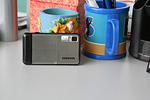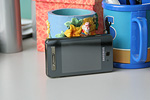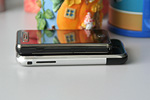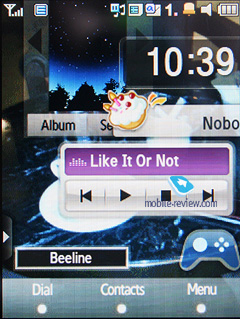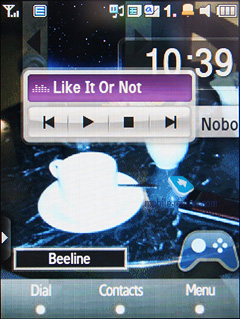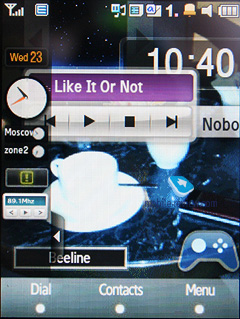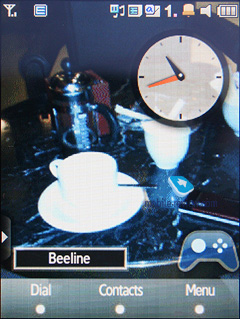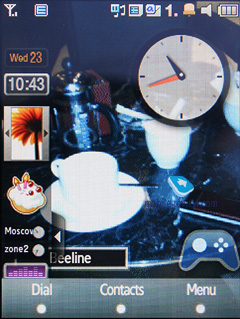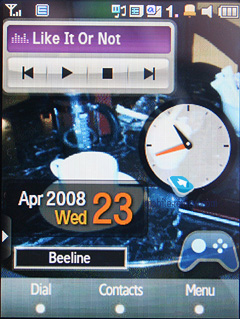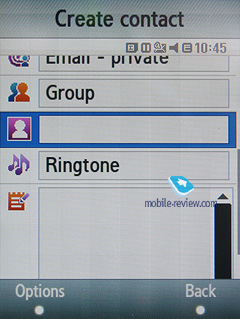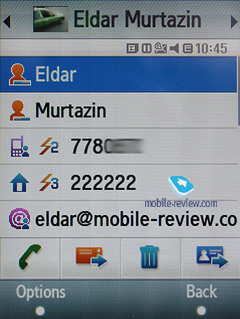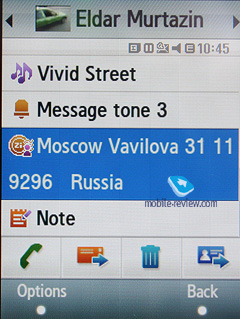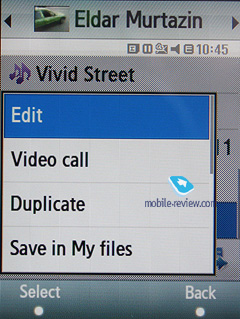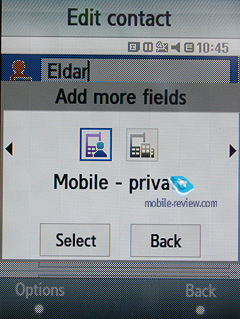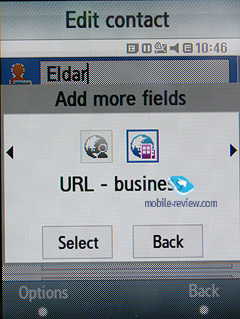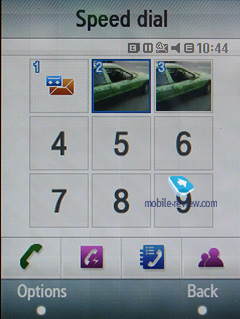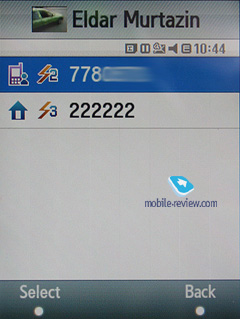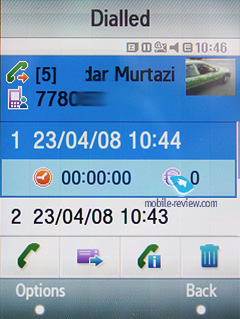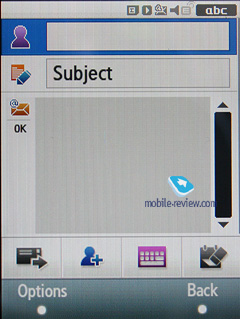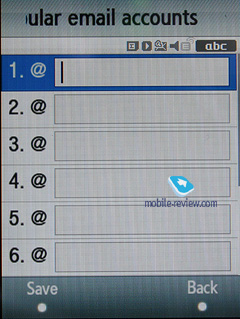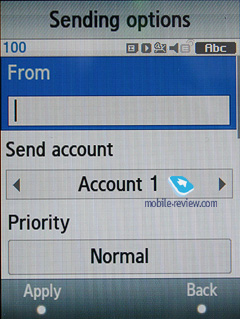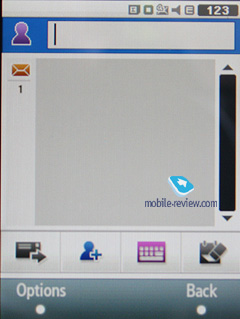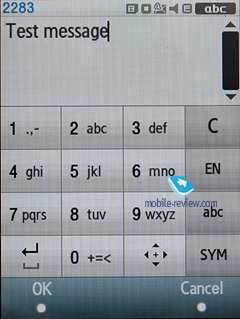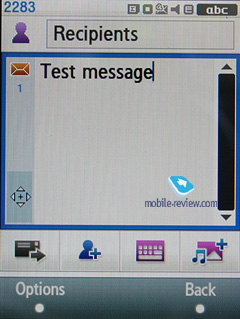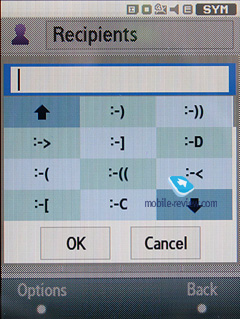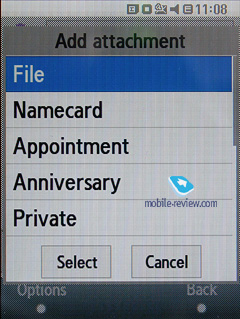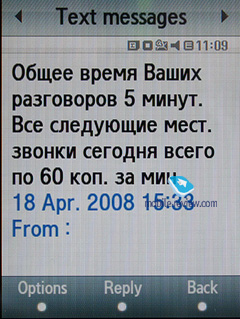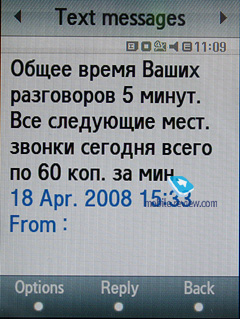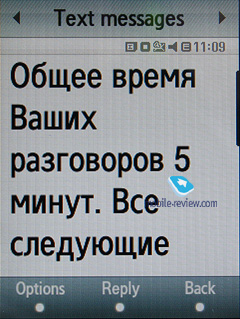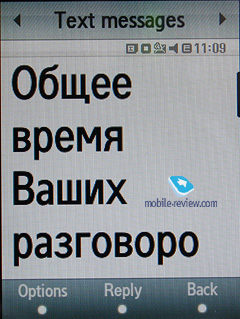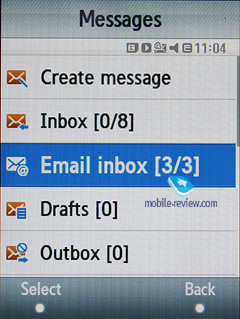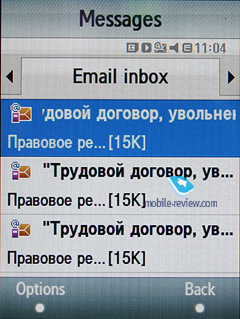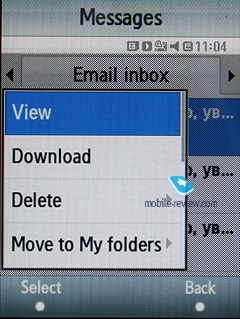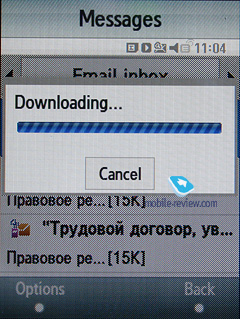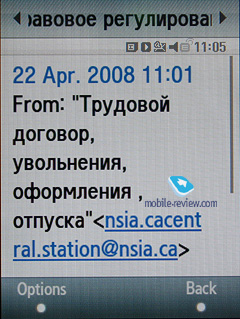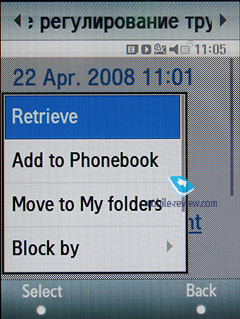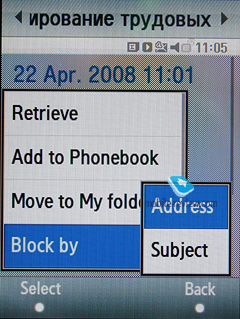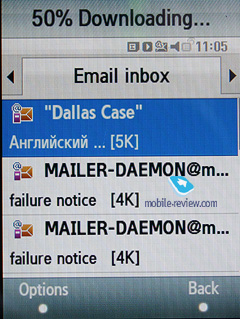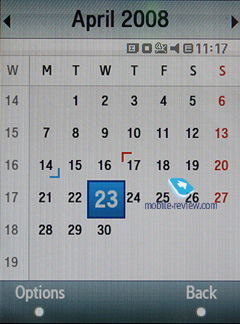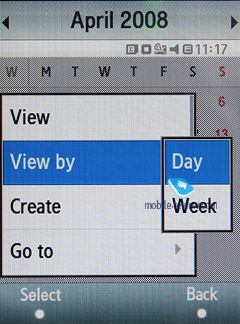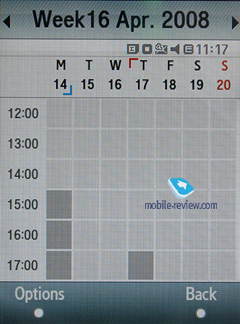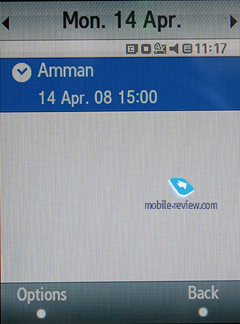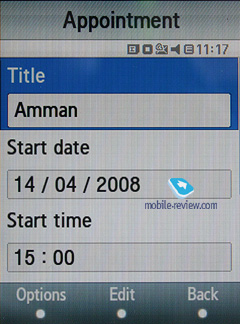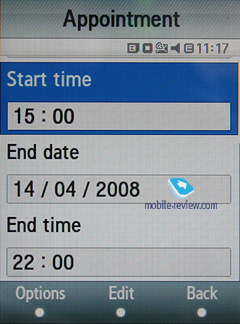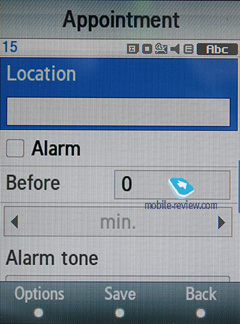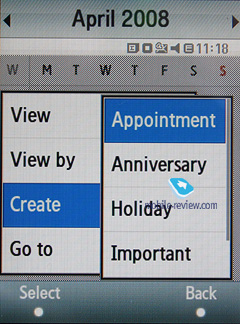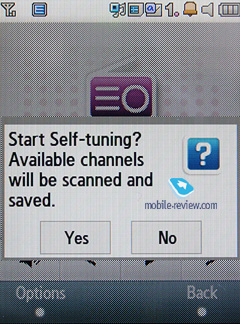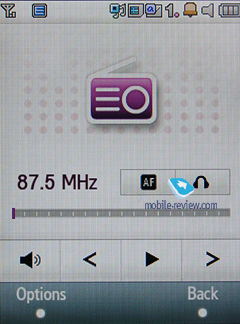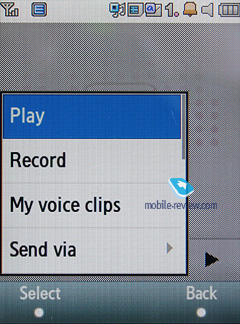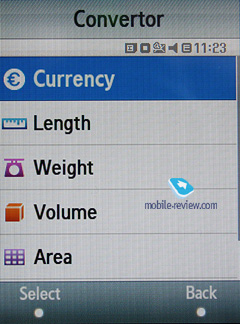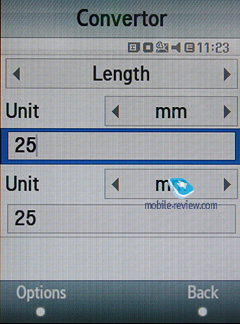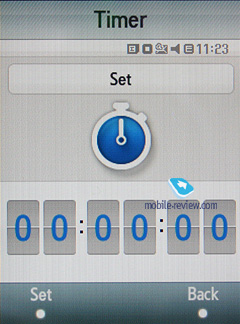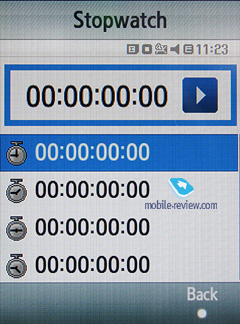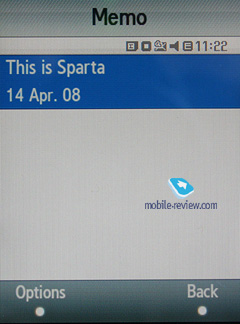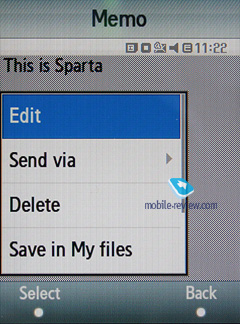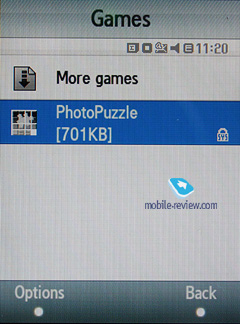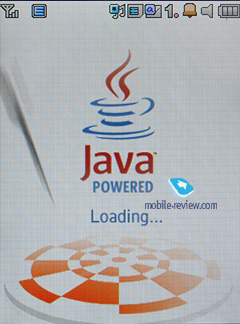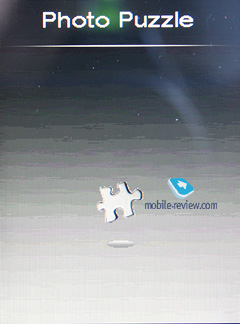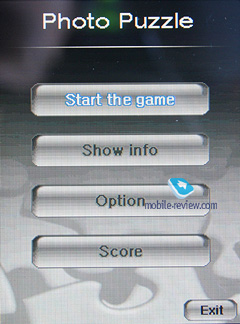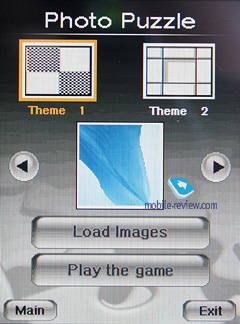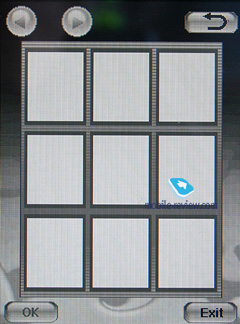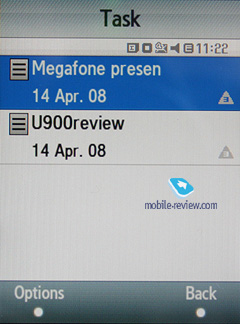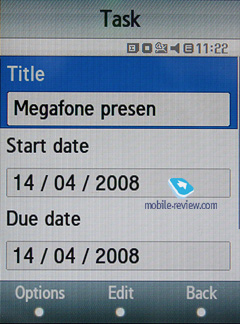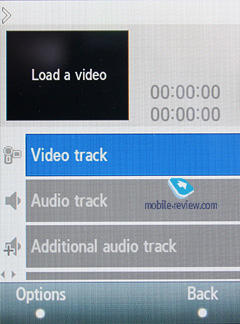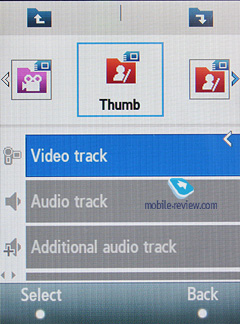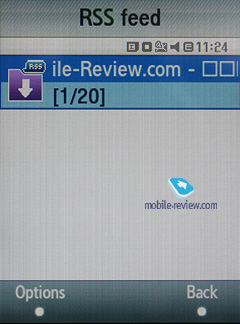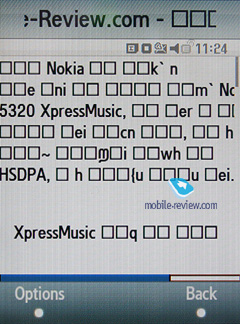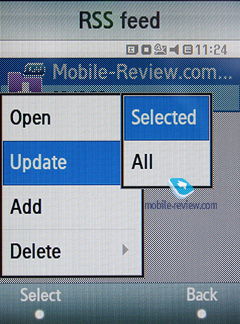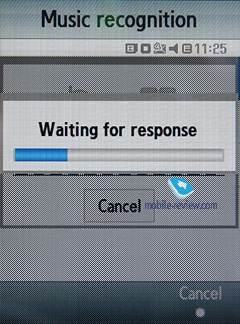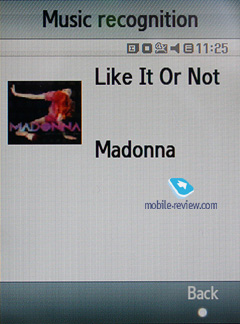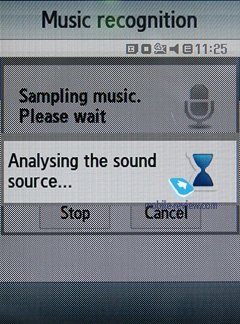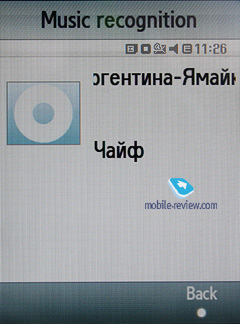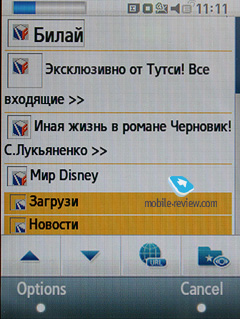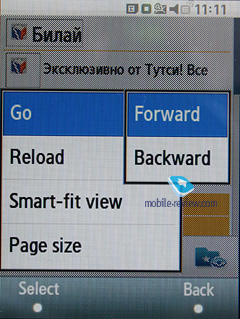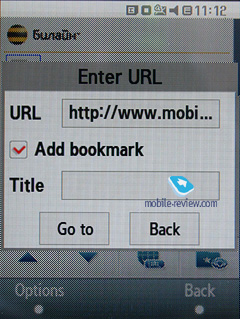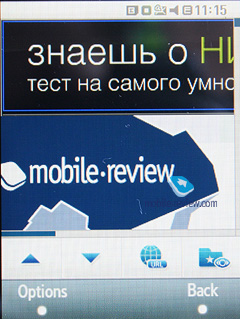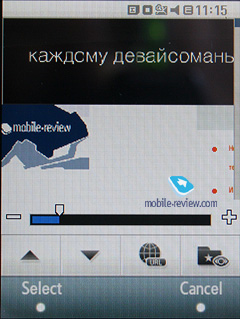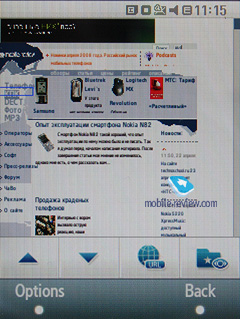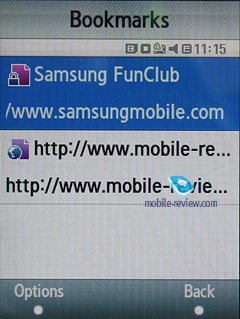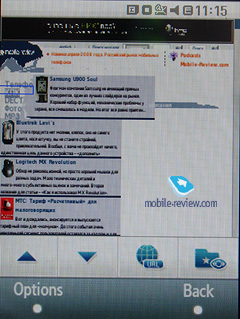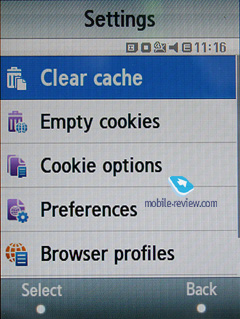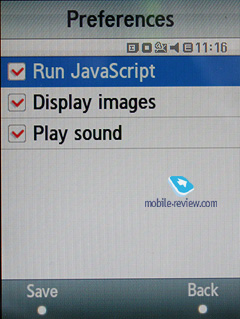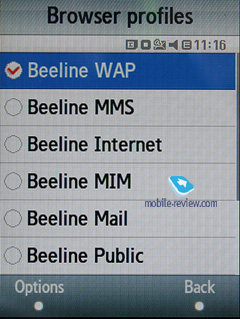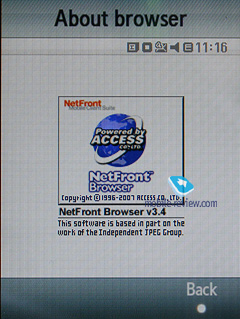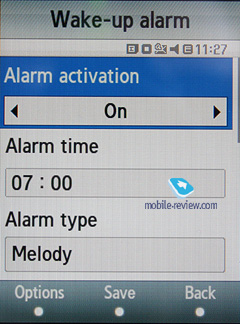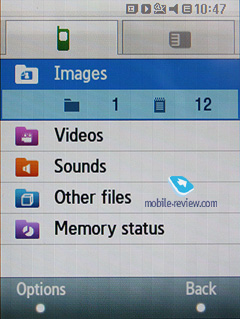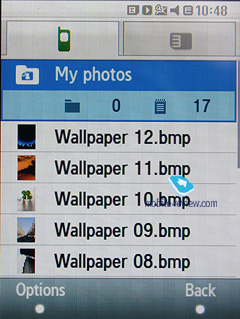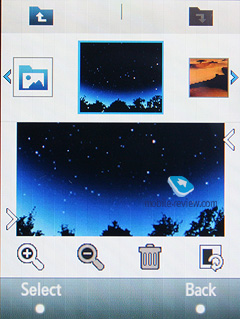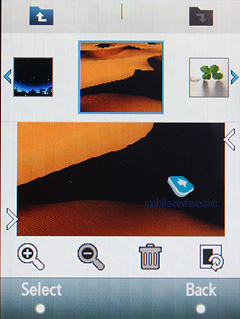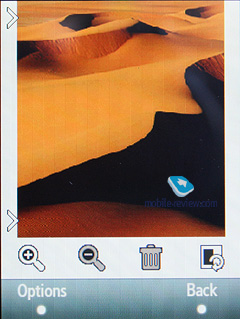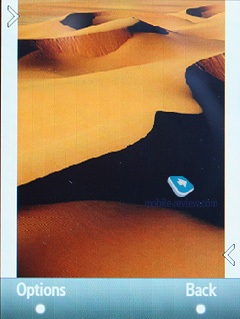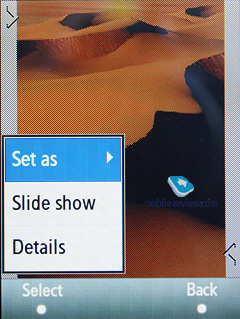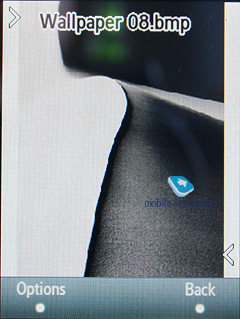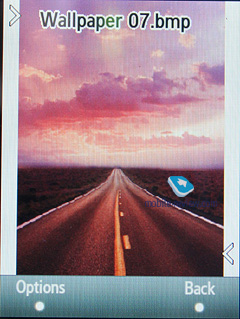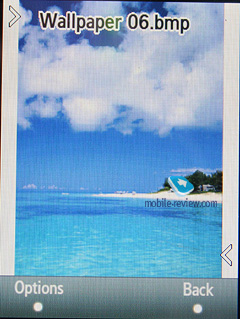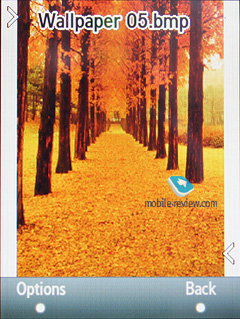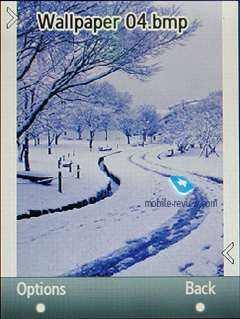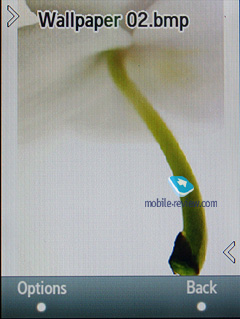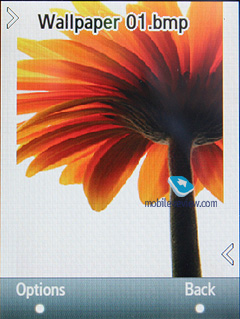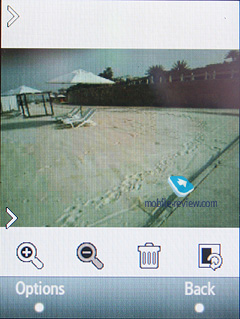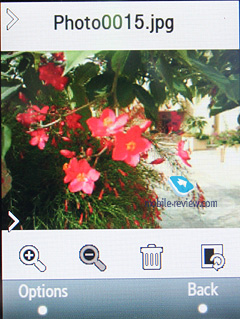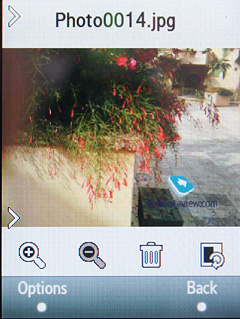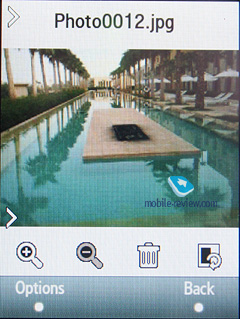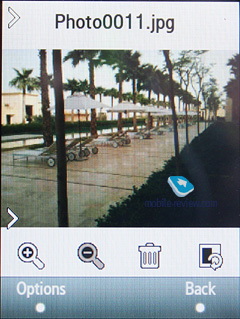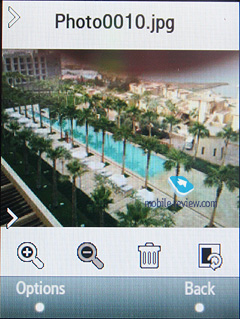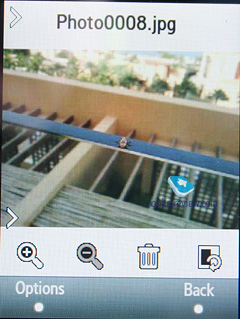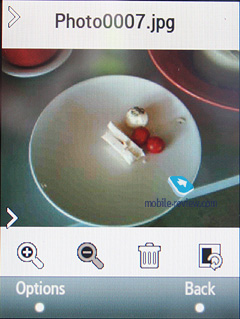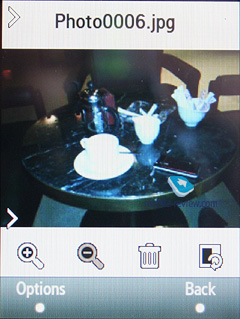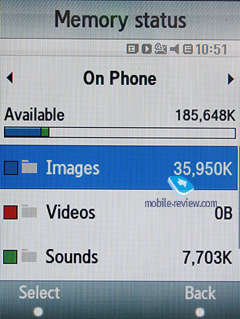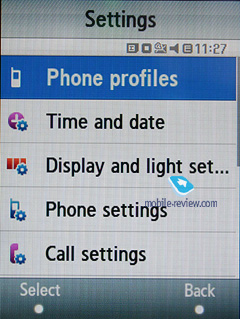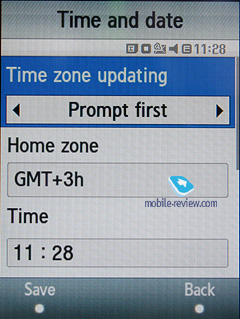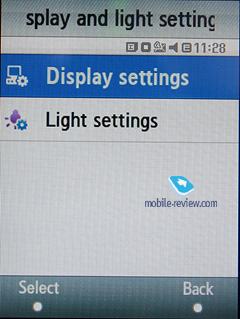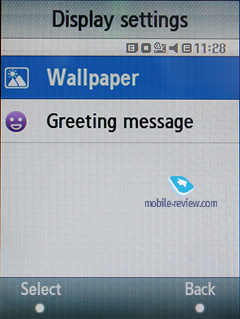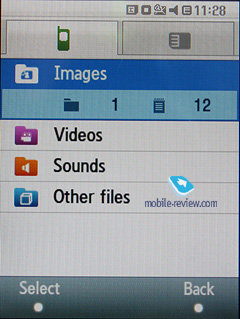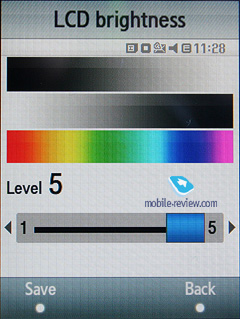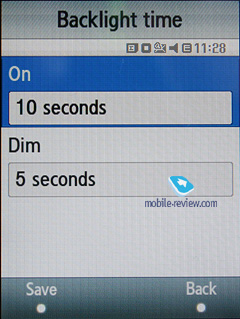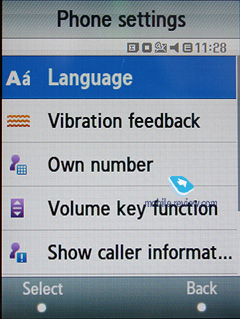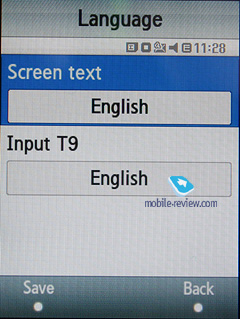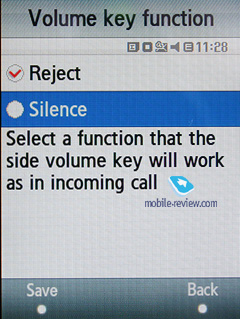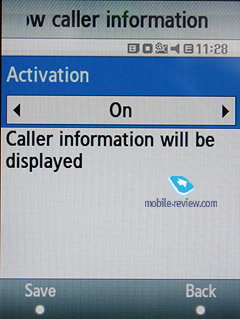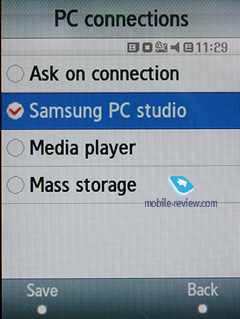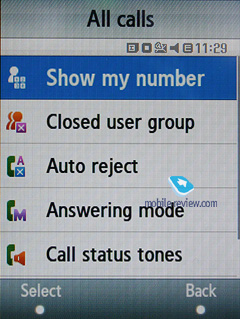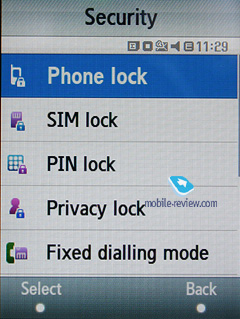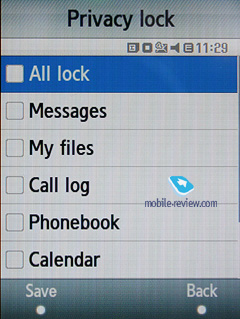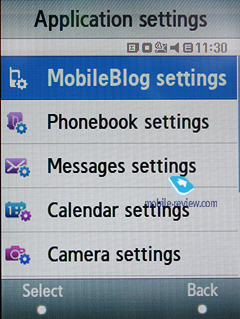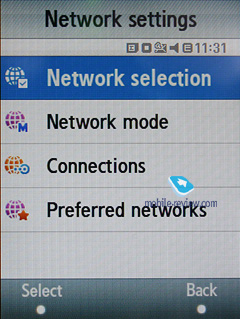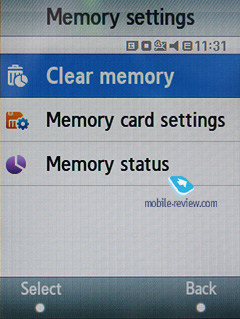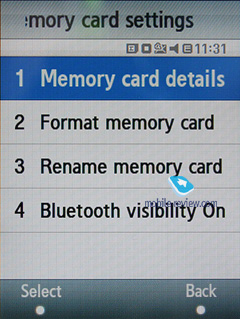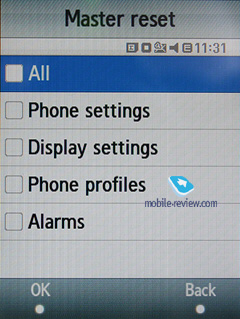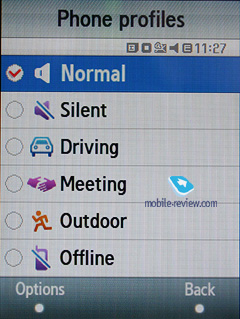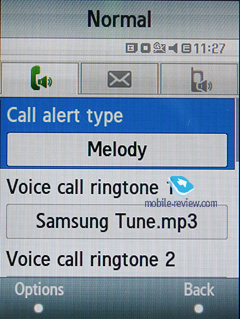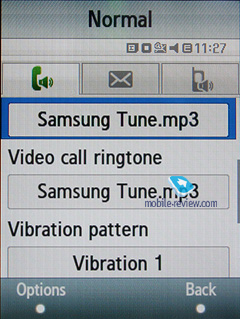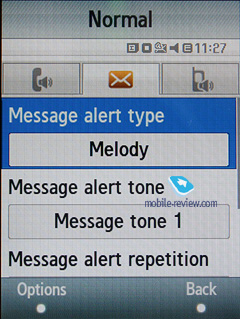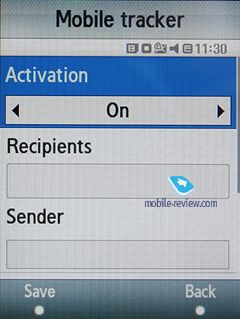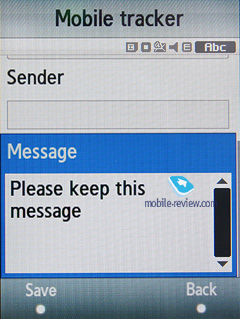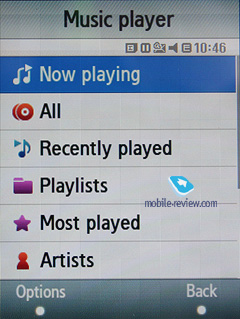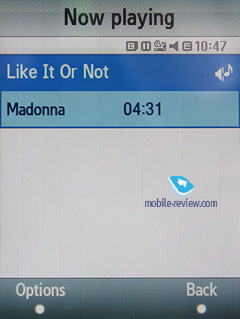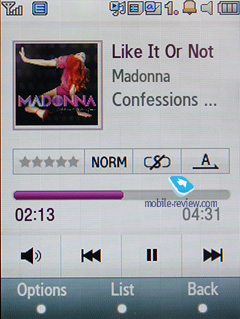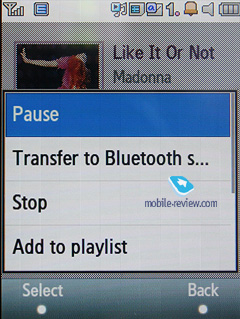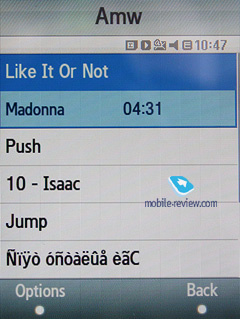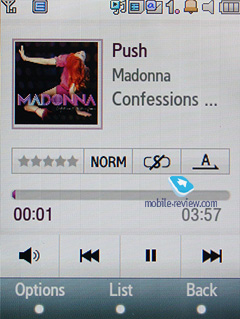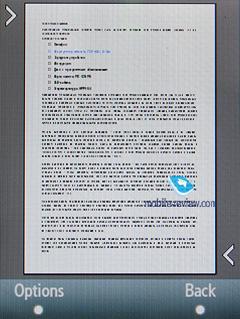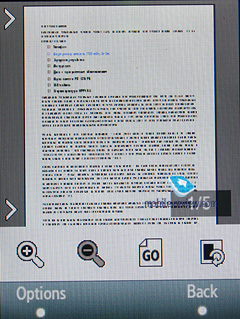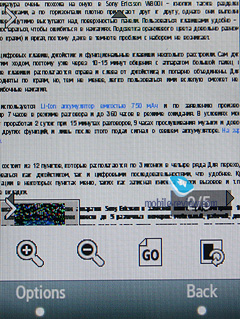|
|
Review of GSM/UMTS-handset Samsung F480
Live photos of Samsung F480
Table of contents:
- Positioning
- Design, size, controls
- Display
- Battery
- Connectivity
- Memory, Memory cards
- Camera
- Menu, Interface
- Phonebook
- Call log
- Messaging
- Organizer
- Applications
- WAP
- Alarm clock
- File Manager (My files)
- Settings
- MP3-player
- Watching videos with the F480
- Picsel Viewer
- Impressions
Sales package:
- Handset
- 1000 mAh Li-Ion battery
- Charger
- Wired headset
- Leather slip case
- USB data cable
- Software CD
- User Guide
Positioning
Many take the F480 as Samsung firing back at the Apple iPhone with its brand new all-touchscreen device sans keyboard. But that would be the wrong way to look at the F480, as Samsung was first to this market and generally its solutions are going in a different direction. In this case, it is a fashion-savvy keyboard-less device taking a whole lot of cues from the Samsung Armani. But whereas the Armani had this “fashion” bit in its very name, the F480 doesn’t have this trait, although it sure isn’t second to its brother in arms price-wise. The reason, as strange as it sounds, is in the Armani itself – had they launched a less expensive, yet a more feature-rich solution, the Armani would’ve been all but buried, and the truth is, it’s not doing great even these days either. That’s why they have added some extra pounds to the F480’s price tag on purpose, not allowing it to spread all over the market. As far as fashion-conscious handsets go, it is not a failing by any means, but rather an essential criterion. Apparently, Samsung is not recognized and praised as much as Nokia in this sense and its solutions are less fashionable on top of that. Within Samsung’s own line-up, the F480 is more of a stand-alone offering, being rather a first stab at the touchscreen market, a bridge connecting their old range with the one that’s already on the threshold.


Back to the table of contents >>>
Design, size, controls
The handset measures up at 95.9x55x11.5 mm and weighs 103 grams. The leather case it comes packaged with sure adds a couple of millimeters to its girth, but all in all, the F480 is very compact and may well drown in your palm. The front fascia houses the forward-facing camera along with three hardware buttons. The bad thing about it is that it’s a finger-print magnet and don’t hope it will make some effort to hide them – it won’t. The rear is made of textured metal and doesn’t tend to pick up scratches with ease.






The microphone pinhole is mounted at the base of the F480. Sitting on the left-hand side is the microSD memory card slot covered by a plastic flap. Further up is the volume rocker. The right-hand spind houses the charger/headphones socket also covered by a flap, dedicated camera button; the Hold switch that locks the display is placed on the top edge.
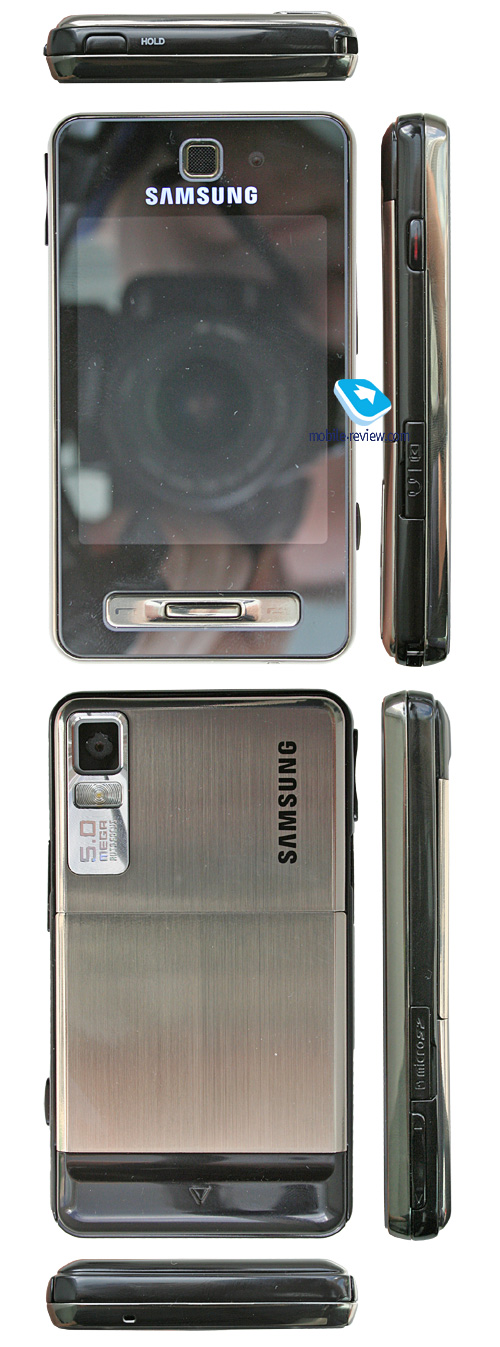


Back to the table of contents >>>
Display
Since the F480 comes with no hardware keypad onboard, the vacant space has been taken over by the biggest display they could only squeeze into the handset – a 2.8-inch TFT-screen with the resolution of 240x320 pixels (42x57mm), showing up to 262K colors. All data input is done via this touch-sensitive display, running the Capacitive Touch Screen technology – in other words, unlike more conventional touch-screens, it packs no sensors and rather employs a special oxide layer on top of its screen, which reacts to touches of your fingers, basically, a stylus or any other sharp object won’t do here. With a pair of gloves on, you will still be able to use the F480’s hardware buttons, while typing up a short message will prove to be impossible.

Among this technology’s edges is the display protection, be it plastic or glass, which provides a higher degree of safety than on standard touch-sensitive panels. Also with the F480 it doesn’t matter how dirty the screen’s surface actually is – you will still get pretty decent reaction time and accuracy.
Samsung-branded offerings also employ the VibeZ feature so as to make the casing vibrate a little, confirming your actions, and we do mean “actions”, since it gives you a buzz only when you tap some action-related keys.
The display accommodates up to 8 text and 3 service lines, but you can cram as many as 10 lines into it while reading a message, depending on the font size you have picked. Text size may be scaled up and down via the side-mounted volume controls (from huge to smallish). You are also enabled to customize the font size and type, although, the available options aren’t very different from each other. What really matters is that unlike most other offerings, the F480 sports hugeish font sizes, which are very readable from almost any distance.

The F480’s display gets heavily washed-out in the sun and become nearly impossible to read, which is, naturally a great drawback.
Back to the table of contents >>>
Battery
The handset utilizes an 880 mAh Li-Ion battery, rated for 220 hours of standby and 6 hours of talk time. In Moscow the F480 lasted around 2 days (an hour of calls, a couple of messages a day, very little email and up to an hour of music). Those who are into mail and web, will squeeze around a day of operation from the F480. But in general, this handset can stay up and running for 1-2 days, and unfortunately, there is no extra battery cover for this handset. It takes the phone around 2 hours to charge up.


Back to the table of contents >>>
Connectivity
Bluetooth. The model supports various profiles, such as Headset, Handsfree, Serial Port, Dial Up Networking, File Transfer, Object Push, Basic Printing, A2DP. EDR-enabled Bluetooth 2.0 is onboard. The headset management is flawless, everything is standard here.
USB-connection. In the menu you may select one of three modes: Media, Mass Storage, Samsung PC Studio. No Modem mode available with the F480, there is even no such option in PC Studio. I hope it will come along a bit later.
While in the USB Mass Storage mode, the F480 shows up on the desktop without requiring you to install any additional drivers, so right after plugging in it’s ready to work. Data connection speeds top out at 600 Kb/s.
You won’t be able to use the F480’s Bluetooth connectivity at the same time as USB – it will require you to disable Bluetooth regardless of its status (connected and transferring data or not), which is very awkward.
When connected to a PC via USB, the F480 automatically recharges itself.
For GSM-networks, the F480 comes included with EDGE class 10.
Back to the table of contents >>>
Memory, Memory cards
The phone ships with 220 Mb of memory onboard – this storage space, give or take, is available to the user right out of the box. The memory card (hot-swappable) is displayed as a separate section, so you can’t access both memory types at a time. The F480 also comes with a file manager, enabling you to copy files to/from the memory card. In our test the handset had no problems handling a 2 Gb microSD memory card, whereas an 4 Gb unit remained unidentified.

Back to the table of contents >>>
Camera
The handset utilizes a 5 Mpix CMOS camera module enjoying a LED flash. You can launch the camera application either from the menu or by tapping the side-mounted dedicated key. The F480’s camera interface is designed to handle well under your fingertips. Shooting mode, video recording and still image modes are all one touch away with this phone. You can also adjust brightness and zoom in/out right on the display.

There are four quality settings available: Super Fine, Fine, Normal, Economy, using the best possible level seems to be the best way to go – the difference between these settings is quite remarkable, especially if you are going to view snaps on PC.
The camera supports the following image resolutions:
- 2560x1920 pixels
- 2048x1536 pixels
- 1600x1200 pixels
- 1280x960 pixels
- 640x480 pixels
- 320x240 pixels
The camera comes with autofocus abilities; however there are no settings for adjusting it. The F480 also packs a new mode – Face Detection, when the camera (obviously) detects someone’s face while shooting (portrait mode) and then it tweaks all parameters to take a better shot. Nevertheless, we didn’t find the shots taken with Face Detection enabled to be any different from the standard mode. The white balance is set to the default option when you open it for the first time, but it can also be managed manually, the following options are available: Daylight, Incandescent, Fluorescent, Cloudy, Sunset. This variety of settings is more likely to appeal to those who just can’t help playing around with all these bars and options, and would fit a digital camera better, rather than a headset, where the philosophy is somewhat difference (take it out and shoot).
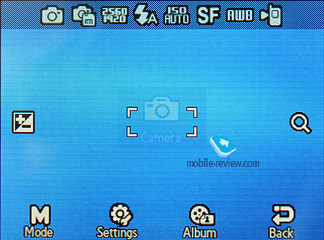
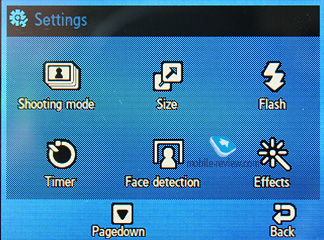
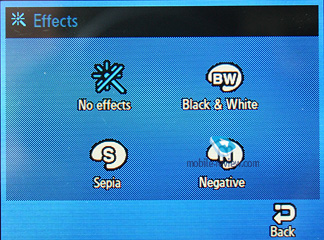
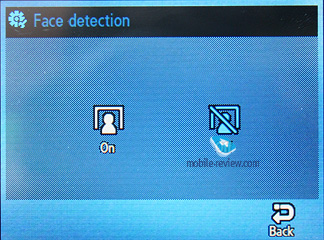
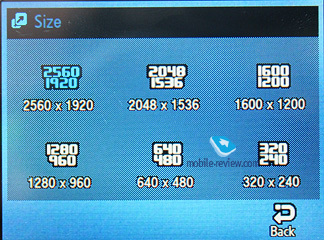
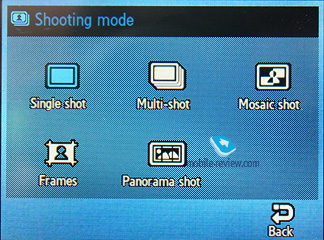
The shutter and zoom sounds may be disabled. The F480 comes with x12 zoom (digital).
The image brightness can be adjusted on a -2 to +2 scale – the default value is 0. In the settings you can also tweak your shot’s sharpness, but since it is a mere filter, playing around with this variable is not a good idea, for the quality won’t change a great deal, while it will have a really hard time editing it on a PC (some details always get smeared up with this filter on).
The camera also allows you to employ various effects while shooting: Negative, Sepia, Black&White. Taking into account the bundled picture editor, which proposes just the same feature pack, “spoiling” the initial photo with effects seems quite pointless.
There is a whole lot of image frames coming with the F480, but they shrink the image size down to 320x240 pixels once you apply one of them.
The settings also enable you to set default name, customize sensitivity (Auto, ISO 50, ISO 100, ISO 200, ISO 400). Personally, I recommend that you use the Auto mode, since it performs quite well and gets the right settings in most cases. On top of that there is no visible difference between the abovementioned sensitivity levels in normal environments – there is no way you can spot changes produced by lower/higher sensitivity in that case. If you would like to take a group photo of your friends, but don’t want to be left out, set a Timer (3, 5 or 10 seconds).
The optical stabilizer allows you to avoid getting blurred shots when your hands are shaking a little. But it is not a stellar performer by any means.
The Mosaic mode downgrades resolution to the lowest possible (the resulting image makes 320x240 pixels in size), so that you could get a grid consisting of 4 pieces (2x2). Generally speaking, it’s a mode for days when you feel like taking some fancy shots.
While in the Multi shot mode, the camera snaps really fast, which makes it possible to get 6 pictures at a time (everything happens is an eyewink), in case this is not what you’re looking for, there is a slower mode as well (gap between shots – one second or a bit less). The modes with 9 and 15 pictures taken in rapid succession are also available. I’ve already said this and will repeat it again: this feature works fine for photo-finishes at tournaments etc., but in real life it won’t be of much use – if you happen to shake the while shooting in this mode, most of the shots will get blurry. The image resolution in this mode switches to 320x240 pixels.
The Panorama mode found in the F480, unlike the Samsung G600 and other phones available on the market, is automatic. This means you just pick the number of pieces you will be splicing together – 3, 4, 5 or 6 shots. Then you point the camera at the first object and take a picture. After that, you don’t need adjust this image to fit the previous one, all you need to do is move the camera to the right, so the phone will make another shot automatically. However the resulting image is not always flawless – if someone happens to pass by in front of the lens, get ready to start the whole thing all over again. Depending of how many pieces you have chosen, your panorama’s resolution will differ.
All photos are stored in the Album, where you can view detailed data on every picture. Any image found in the Album can be assigned to a contact in the phonebook or set as a wallpaper outright. The slide-show mode and a basic editor (allows applying emoticons, frames and special effects) are at your disposal in the F480.
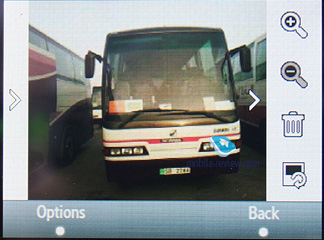

 |
 |
| (+) maximize, 2560x1920, JPEG |
(+) maximize, 2560x1920, JPEG |
 |
 |
| (+) maximize, 2560x1920, JPEG |
(+) maximize, 2560x1920, JPEG |
 |
 |
| (+) maximize, 2560x1920, JPEG |
(+) maximize, 2560x1920, JPEG |
 |
 |
| (+) maximize, 2560x1920, JPEG |
(+) maximize, 2560x1920, JPEG |
 |
 |
| (+) maximize, 2560x1920, JPEG |
(+) maximize, 2560x1920, JPEG |
 |
 |
| (+) maximize, 2560x1920, JPEG |
(+) maximize, 2560x1920, JPEG |
 |
 |
| (+) maximize, 2560x1920, JPEG |
(+) maximize, 2560x1920, JPEG |
 |
 |
| (+) maximize, 2560x1920, JPEG |
(+) maximize, 2560x1920, JPEG |
 |
 |
| (+) maximize, 2560x1920, JPEG |
(+) maximize, 2560x1920, JPEG |
 |
 |
| (+) maximize, 2560x1920, JPEG |
(+) maximize, 2560x1920, JPEG |
 |
 |
| (+) maximize, 2560x1920, JPEG |
(+) maximize, 2560x1920, JPEG |
 |
 |
| (+) maximize, 2560x1920, JPEG |
(+) maximize, 2560x1920, JPEG |
Video recording
The handset records video in mpeg4 format at the top resolution settings, on top of that in the options you can either enable or disable sound. All the settings here aren’t too much different from the single shot mode, yet new resolutions plus a bunch of effects. Max resolution – 320x240 (15 FPS). Video quality wise the F480 is an average performer by contemporary standards.
Back to the table of contents >>>
Menu, Interface
Samsung’s first touchscreen-powered offerings made use of the Croix interface, but starting from the Samsung F480 they will be searching for new solutions and keep experimenting in an effort to render their phones more usable, user-friendly and intuitive. In this sense the Samsung F480 is a leap forward – it has had its interface utterly simplified, all major features are now housed right on the standby screen, and on top of that you are allowed to draw the list of own applications and functions and tack it on the screen. It is also the first time we have come across Widgets in Samsung-branded phones – in a word, they allow displaying various information on the screen. Curiously, Sony Ericsson and Nokia are going in the same direction, they have also been heavy on Widgets of late, but their solutions are somewhat different, that is, you can have only one active widget at ever given moment. However, Samsung enables you to have more widgets around, but they are less sophisticated at that. To make this difference clearer to you, let me give an example: Nokia will provide a widget featuring current weather forecast, where you will be presented with temperature, immediate forecast and other useful bits of into, whereas with Samsung-branded handsets all you’ll see will be a plain window with a selection of numbers. By the way, as you today no Samsung’s phone can boast this functionality.
While at the standby screen, the display’s base is occupied by a bar containing three shortcuts to the dialing screen, phonebook and menu. On the left is an arrow, tapping which will expand the applications bar, allowing you to drag any Widgets to the screen (their layout is also adjustable). Obviously, the F480 looks so much nicer with only a handful of windows tacked on, rather than a cacophony of widgets all around its real estate. Let’s take a look at what things you can be up on the screen:
- Carrier’s name
- Date and time
- Analog clock
- Digital clock
- World time (for any chosen city)
- Player controls
- Radio controls
- Album with thumbnails (you can also scroll through images with it)
- Games shortcut
- Events (missed calls, SMS)
- Birthday reminder
- Profile switcher
It doesn’t take a rocket scientist to see that Samsung’s Widgets allow the user to tune and tailor the display’s layout to his/her own liking. Unfortunately, sooner or later you will run into the only real limitation of the F480 in this department – physical size of the screen; naturally, we’d like to be able to cram more elements into it. But, it is what it is today, even in this state Widgets is the most flexible solution out there and it’s definitely ahead of Nokia’s Active Standby.
You can enter the main menu by pressing the icon at the top of the screen. The numeric keypad is called up from the standby mode hands down, which is also pretty convenient.
The main menu is displayed as a 3x4 grid. The touch-sensitive display is easy to handle – you tap the item you need, then bring up a data input field by double-pressing it, since the first one will select it, and the next one will enabled the on-screen keypad.

All texting is done via the on-screen keyboard, which is almost identical to that of conventional looking handsets – it houses twelve buttons with a batch of symbols attached to each, so in order to type some particular letter you will need to tap one of these buttons sequentially. Naturally, many will wonder why the F480 comes with no QWERTY-keyboard if it packs a touch-sensitive display. Well, while it makes for a tad speedier typing, the user also gets more misclicks, which negates all advantages of a virtual thumbboard. Essentially, touch-screens are great for moving around menus, not texting.

You also opt for the T9 predictive text input system for typing, but the way it is implemented in the F480 leaves much to be desired. When texting you see a text box topping the display, where words pop up, and the bad thing about the handset is that it doesn’t actually predict words, meaning that you won’t see a word until you have entered it. On a very rare occasion when two words share the same key sequence, you will be allowed to use the directional arrows to scroll through the list of alternatives, but you won’t see it either. In my opinion, there is no reason to disable the T9, as you won’t boost your text input speed this way. One more thing marring the handset’s messaging department is that while you actually can add words into the dictionary, you will have to go through hell to do that.
The handset allows you to toggle between any of the preinstalled languages. From the menu you can use the text editing mode, when you will be able to select a fragment, but not copy it. Being able to select text, however, also comes in handy when you need to alter fonts or something.
Unlike previous solutions, the F480’s horizontal lists are not indexed, which is a trait brought about by the lack of a hardware keyboard.
All applications feature a context-sensitive tool bar at the foot of the screen.
All applications, whose menus provide you with a number of options, also house removable icon bars with them, which is an extremely convenient layout.
Another positive thing of note is that you can pull up extra tool bars onto the display. When viewing photos, for example, this tool bar displays thumbnails from neighboring files, so that you can select then in one touch. For messaging, these may be extra panels with some particular functions.
Ergonomics-wise, the F480 is not always intuitive, but overall, it is an easy-to-use device. Had the T9 mode been a little better, we would have experienced a considerable boost in texting speed over feature phones, but, regrettably, that’s not the case wit.
Unlike other solutions, the F480 enjoys an enhanced mechanism of list scrolling. For instance, if you brush your finger along the right side, you will see that lists are scrolling down slower than when you perform the same gesture on the left. It may not seem like much, but this tiny detail improves the handset’s usability substantially.
Back to the table of contents >>>
Phonebook
You can call up the phonebook by tapping the shortcut at the standby screen; you will see a list that contains all entries from both the SIM-card and phone’s memory. There are four tabs tacked on the display, the first one leads to the dialing display. The second tab comprises contact groups, so that you can switch to them in no time. Third tab – contact groups. The list doesn’t feature images assigned to entries.
The field beneath the name is the default number, which can be picked manually from the list of submitted numbers for a particular contact. Quick name search by first letters is supported; there can be up to twenty of those, for any language. Once you tap the entry you will go into a detailed view of the selected entry. There you will see a thumbnail, if any. It can be an image, a photo or a video clip. Each entry can have up to 5 phone numbers of different types (mobile, office, home, fax other), one of them will be main number (by default it is the first one you entered). All fields are hardwired.
There are two lines for First Name and Last Name (search is performed only by the former), these fields get merged when displayed in the general list, and First Name comes first. For example Eldar Murtazin will be shown only in this order. Length of each field is 20 characters for any supported input language. You can also switch languages on the fly when entering a name.
All entries, regardless of language, are sorted out in the following way – all contacts with headings made in a local language (Russian, for example) go first and then those with names in English. This is a rather convenient and handy list sorting system. Taking into account fast language switch option during the search, it’s clear that no language will spoil the experience of working with this phone. The list can be sorted by first or last name.
But let us return to the information entered for a contact. Apart from phone numbers, e-mail address (there may be several of them), a little text memo can be submitted on top of all that. Any music file (including MP3) can be picked as a ring tone for a contact. Three caller groups are provided by default with the possibility for creating any number of additional groups, setting a personal melody and image for each (by default there are three groups). SMS alerts are not customizable.
The phonebook is capable of holding up to 1000 contacts with filled in data fields. Even if all the available blanks are not used, the cap won’t get any bigger and will still make one thousand. It is possible to specify in the settings where all new numbers should be kept by default. There is also an option for moving entries from the SIM-card, although the reverse action is denied. According to the developers, PC (MS Outlook in particular) is best for data synchronization with the F480. Any contact in the form of SMS/MMS, mail message or other text file can be quickly sent through Bluetooth to another device. There are no problems with sending, and the phonebook entry gets beamed to another device, where it is read without any trouble.
The phonebook may contain a business card as well, though its structure copies all the fields found in a regular contact in the phone book.
There can be up to eight numbers in the fast dial list; separate numbers tied up with a single contact may appear on this list as well. The chosen entry (not of the phone number type) is displayed on the buttons as the subtitle.
You can create any number of caller groups, assign up to 20 contacts and customize them with a picture and tune.
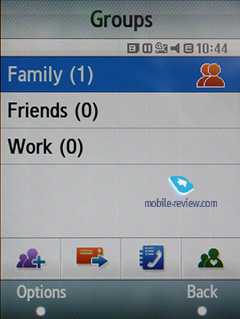
On an incoming call, the caller ID picture occupies almost the entire screen.

Back to the table of contents >>>
Call log
Each of the given lists contain up to 30 phone numbers. There is a combined list of all the last calls with an icon indicating call type. You can quickly switch between the lists. The date and time of the calls are displayed in the extended view for separate entries. Calls from/to one number are grouped up, so that the number standing next to the call specifies total number of calls made. As always, the overall time of the calls and their cost can be viewed in this menu (in the case that the service has been enabled).
For individual numbers you can arrange a black list, which will reject all calls coming from these contacts.
From this menu you can also access the list of numbers you received/sent SMS messages from/to (two list), as well as all email addresses you have used lately.
Back to the table of contents >>>
Messaging
Much like other makers, over at Samsung they have forgone that artificial division into SMS-MMS types – you just start composing a message, and only then, depending on the contents, it is attributed to SMS or MMS. The menu still holds an option for switching message into MMS mode (for example when you need to send only text, but to an e-mail address, without calling up the bundled client).
The phone memory can hold up to as many as 500 messages; the handset supports EMS standard compatible with Nokia Smart Messaging. While choosing recipient, you can either select a telephone number from your contacts or pick one from the call lists or groups. All messages are manageable, this means you are at liberty to move a certain number to your black list, in order to make sure all messages coming from that phone number will be deleted automatically; possibility for moving messages to any own folder is also at your disposal. For e-mail you can move not only addresses to the blacklist, but unwanted subjects as well.
There are no size restrictions as far as received messages go, though an outgoing message’s size is limited to 295 KB. As for additional services available with the F480, message rejection and message retrieval type options are onboard. All messages are stored in general dynamic memory, the same goes for e-mails.
Also there is a useful function for sending SOS-messages – when activated, should you find yourself in an emergency, after pressing the volume key four times, the message «I am in emergency. Please help me» will be sent to contacts submitted earlier, all incoming calls from these numbers upon sending the emergency message will be picked up automatically. Recipients (not more than 5), as well as the number of Repeats may be set up manually, while the text of the SOS-message is not customizable.
The bundled mail client is standard in all its components – 5 accounts and the maximum of 100 incoming messages; attachments are also handled by the phone, though there are also several caps – there’s no way you can receive a file more than 500 Kb big, or send one with size exceeding 300 kb. Received files can be viewed via the bundled browser. The F480 doesn't support html in emails, which breaks formatting of most letters you receive, so they become really awkward to read. The mail client found in Samsung-branded phones is now falling behind those embedded in Nokia’s and Sony Ericsson’s solutions.
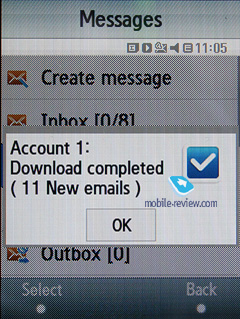
Back to the table of contents >>>
Organizer
The phone’s memory can store as many as 100 events of one type – meeting. There are other event types as well, like anniversary and holiday, with the maximum capability of 100 events (2x5). The F480’s to-do list can also hold up to 20 entries.
Day and time as well as end time of an event are indicated for each entry. Alert signal and its duration can be adjusted to your liking; repeatable events are available for setting up (repeat time is also manageable as well as the exceptions). The weekly and the monthly calendar views are very convenient with each type of the event having its own color.
Speaking of the organizer’s shortcomings, I cannot overlook the fact that when typing date and time for an event, the end time doesn’t change, which badly hurts its ease of use – other manufacturers make the due time shift automatically (by default any event takes one hour).
Back to the table of contents >>>
Applications
You can store up to 20 radio stations in the memory; the range of available frequencies is 87.5-108 MHz. Also, you can enjoy auto-tuning, but particular channels cannot have own names attached – they are always shown as the frequency numbers. The radio can work in handsfree mode, plus it enables you to set it up as an alarm clock, but regardless of how you are going to use it, a plugged-in headset is a must, since it doubles as an antenna. The radio implementation is fine, although it doesn’t pick up all stations equally well, but on balance, it is quite competent in comparison to other vendors’ offerings. The radio can be minimized.
RDS here displays only the station’s name in the general list, no advanced options available.
Voice recorder. You can record up to several hours of voice memos with the number of files being unlimited. Basically, limitations on recording duration are set by the user himself, though length of a single recording cannot exceed 1 hour. All the files are stored in a separate folder in the memory bank. The recorder performs well during lectures, conferences and presentations – I could even say that it is a partial substitute for a digital tape recorder.
World time is displayed for two chosen cities.
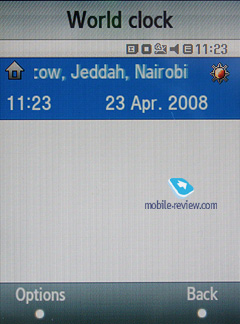
Calculator It divides, multiplies, subtracts and adds and does several more things – quite enough for a mobile calculator.
With the converter, you can operate with different units of measurements as well as with a number of currencies.
Countdown timer and stopwatch have no bells and whistles.
Memo – standard text notes.
Games – the F480 comes installed with PhotoPuzzle. There is no way to upload new games, at least for now. The maker will release a special SDK for Java-games tweaked for this particular model.
Tasks – a to-do list allowing you to set different priorities and adjust alarms.
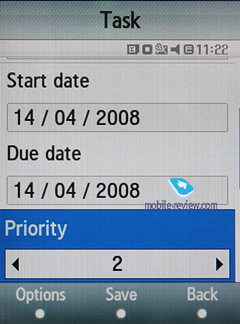
Video editor. Allows editing video clips and overlay sound tracks. The most basic editors that makes its first appearance with the F480.
RSS Reader. This is a stand-alone utility for RSS feeds. However, it would make more sense if the RSS Reader was bound up with the web-browser, but this is not the case with the F480. This way, RSS links are not picked up by the browser, or sent directly to the application. You will need to manually submit a channel address in this app to subscribe, or enter a web address and let the application try to find an RSS channel on it.
While uploading your news feed, the F480 can upload text, as well as video and audio files, and it is up to you to set the size limit (by default – 5 Mb per file). Regrettably, there no scheduled feed updates are available, thus you will need to refresh the feed manually every time you need hot news.
Obviously with this application Samsung is having a first go at this field, and the truth is, it is not really functional or appealing the way it is in the F480. Similar solutions found in the phone from other makers pack more punch and are easier to manage.
Music Recognition – a mere alternative to Sony Ericsson’s Track ID. The gist of this service is this: you record a short clip from some music track you fancy and then the phone finds you its title and artist.
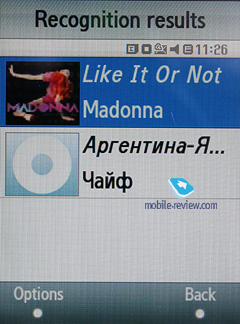
Back to the table of contents >>>
WAP
The handset comes with a wap-browser version 2.0 (NetFront 3.4), where apart from JavaScript support, fonts scaling (three types), Smart-Fit (single-column view), full-screen mode (all controls are hidden), page caching, they have embedded a new feature – on-screen ‘mouse’ pointer. Much like Nokia’s S60-powered handsets and Opera Mini, you can view pages with a tiny navigation window displayed. The browser itself packs a lot of goods under the hood and will be appreciated by most users.
While browsing, you will see two directional arrows for moving around web-pages. The usability of this solution is questionable – basically, browsing is not the forte of the F480, despite its pretty decent browser application.
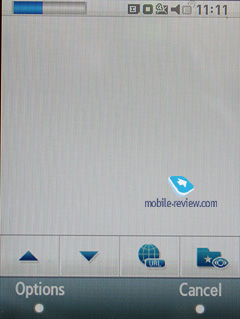
Back to the table of contents >>>
Alarm clock
The handset comes equipped with four alarm clocks, each of them can go off on certain weekdays. You can also pick one of five tunes, or turn to MP3 tracks. In settings it is possible to enable auto power-up when any event triggers.
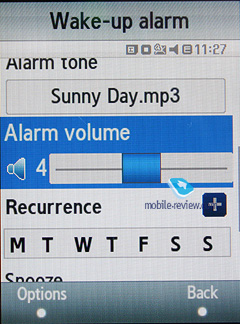
Back to the table of contents >>>
File Manager (My files)
That’s the place to search for all files such as music, pictures, video and sounds. Any uploaded file gets stored here. The disadvantage is that files sometimes are not displayed in the list immediately - in that case you will need to leave the menu and enter it again.
Files and folders can be viewed either as a list or thumbnails. You can mark any number of files. The handset supports Move, Copy and Delete operations, as well as various types of sorting (by type, name or size).
Memory card’s file structure is a slightly different story, as it can be accessed through the main menu, where each item features “Memory card” option.
What I want to emphasize here is that Java applications can’t be uploaded over the air or via any other means, even though the Memory section of the menu claims this feature is supported. In theory, games specially designed for this particular handset can be uploaded on top, but in fact there are only two games of this kind.
Back to the table of contents >>>
Settings
Traditionally this item boasts a standard set of options inside like password protection of selected sections. Keypad light – there are three options at your disposal, one of them is Night mode, implying that backlighting will be active only between 5:00 PM and 9:00 AM and disabled during daytime. If you come to think of it, this feature is nothing more but an illusive replacement for ambient light indicator, which Motorola’s handsets are armed with.
No special or quaint settings are available with the F480. It only comes with an assortment of wallpapers and the ability to swap them randomly. But you can create animated slide-shows with them, apply various effects and thus make your standby screen morph into an eye-catcher.
The F480 comes preloaded with profiles enabling the user to change the settings momentarily.
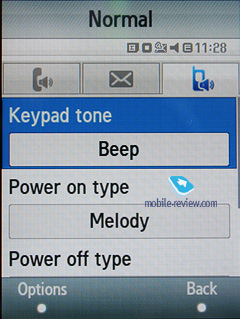
The font size, as well as its color and style are also adjustable.
The user can also modify vibration power for the VibeZ.

Back to the table of contents >>>
MP3-player
The F480 comes with a bundled mp3 player, supporting random, sequential and cyclic playback. Mp3 files can be uploaded onto the handset both directly over Bluetooth and through the sync application or Windows Media Player. There are no limitations on tags and names of music files. Bitrates are not something that really matters either – the handset easily deals with all available formats and supports WMA, AAC, eAAC, eAAC+
The title of the currently played back track is displayed as well as the number of the remaining tracks. There is an equalizer is embedded in the F480, but no way to tune it. Your tracks can be played through the stereo headset as well as the speakerphone. The volume bar has 14 scales on it. And of course the user can make up their own playlists. The player can work in minimized mode – in this case the display will show current track title and music controls, which is a good thing.
The player boasts the following filters: all tracks, recently played, most popular, artists, albums, genres and composers. The F480 also sports Album Arts support.
Speaking of new options, the player has obtained the rating system, enabling you to award any track with one to five stars. The maker has driven the integration with Windows Media Player as deep as it has never been before; actually, this manager also sports the rating system.
The bundled headset has a socket for plugging in custom earphones and ensures pretty good sound quality overall. Generally speaking, as a music-minded solution, the F480 comes close to Sony Ericsson’s Walkman range, especially as far as the first generation is concerned. The music key makes Walkman-branded handsets comes across our minds, as it allows the user to launch and minimize the player with one press. While at the standby screen, if you have the music player minimized, you will see its controls and current track title right on the display.
While in the loudspeaker mode, the F480 is not the best performer we have seen – it plays somewhat distorted sound and obviously lacks power, even though the sound doesn’t seem to be muffled.
The F480’s music quality with custom headphones plugged in is pretty good, although it ends up behind other Samsung-branded models – there is no point in considering it a music-minded solution, even though it packs a 3.5 mm audio input.
Back to the table of contents >>>
Watching videos with the F480
Some words about how the F480 fares on the video front – thankfully, its widescreen gives it all it takes for a decent experience. The phone supports mpeg4, H.263 and H.264, which allows you to drag and drop movies onto the memory card. In fact, maximum file size is unlimited, at least in our tests we used 600-700 Mb movies and experienced no hardships with them.
But the biggest letdown here is also one of the best things about the F480 – its display. Sounds awkward, right? However, if your video is 240x320 pixels big, it won’t occupy the entire display, since the handset can’t fit the picture into the screen size, leaving black stripes on all sides. Where the Apple Touch excels, the F480 can’t make a movie look good. You can also opt for bigger video resolutions, but at the cost of having occasional freeze-ups and blockiness. The F480 is a contradictory device that has all the makings of a video-savvy solution, yet doesn’t provide a top-notch implementation for this department.
Back to the table of contents >>>
Picsel Viewer
Putting it short, Picsel Viewer is an application that opens MS Office files (for instance, MS Word, Excel, PowerPoint), Adobe Acrobat (PDF), picture and video formats on the phone. The attraction of this technology is its speed, when a 20 MB PDF file takes a couple of seconds to open, then you can quickly page through it, zoom in/out and rotate pages. No editing abilities here, only viewing is available with the F480, but that is pretty much enough already, especially considering there is no need in extra conversions.

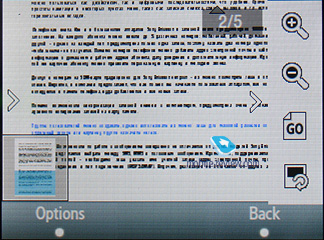
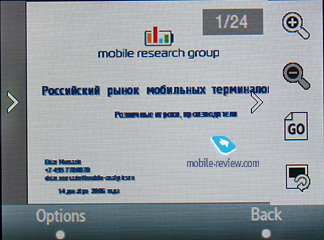
Back to the table of contents >>>
Impressions
The reception quality was never an issue with the Samsung F480, as it was in line with other offerings available in this class. Our ring tones had average volume or a tad lower than that – we would miss our calls even with the F480 in our pocket often enough. The vibro alert was moderate strength-wise, retaining no edge over other Samsung-branded solutions.
In Russia, where there are more than five hundred thousand Apple iPhones as of today, the fate of any device akin to it in any way is not very bright and promising, and the Samsung F480 is no exception. Retailing for the same money as the iPhone it lags behind the latter on many fronts, even though it trumps it as a phone. And taking into account that the iPhone’s price tag is almost twice as light in the US, it won’t take you long to see the clear winner in this contest.
So, who might need the Samsung F480? Primarily those who crave for better imaging experience, although the F480 is certainly not the man to beat, so to speak, yet it is okay for a device this svelte. Also going for it are a fair bit of fashion, good battery life, palm-friendly dimensions, a responsive display with very few bugs (occasionally it just freezes for no obvious reason) – all in all, it is a likable offering, although with its 500 Euro price tag by no means cheap. While it will get more affordable with time, don’t expect dramatic swings, the level of 380-400 Euro is as far as it can get in six months’ time. While the F480 won’t appeal to just about everyone, it is a nice and easy to use phone, very different from the Samsung Armani experience-wise at that.
Related links:
Back to the table of contents >>>
Eldar Murtazin (eldar@mobile-review.com)
Translated by Oleg Kononosov (oleg.kononosov@mobile-review.com)
Published — 05 May 2008
Have something to add?! Write us... eldar@mobile-review.com
|
News:
[ 31-07 16:21 ]Sir Jony Ive: Apple Isn't In It For The Money
[ 31-07 13:34 ]Video: Nokia Designer Interviews
[ 31-07 13:10 ]RIM To Layoff 3,000 More Employees
[ 30-07 20:59 ]Video: iPhone 5 Housing Shown Off
[ 30-07 19:12 ]Android Fortunes Decline In U.S.
[ 25-07 16:18 ]Why Apple Is Suing Samsung?
[ 25-07 15:53 ]A Few Choice Quotes About Apple ... By Samsung
[ 23-07 20:25 ]Russian iOS Hacker Calls It A Day
[ 23-07 17:40 ]Video: It's Still Not Out, But Galaxy Note 10.1 Gets An Ad
[ 19-07 19:10 ]Another Loss For Nokia: $1 Billion Down In Q2
[ 19-07 17:22 ]British Judge Orders Apple To Run Ads Saying Samsung Did Not Copy Them
[ 19-07 16:57 ]iPhone 5 To Feature Nano-SIM Cards
[ 18-07 14:20 ]What The iPad Could Have Looked Like ...
[ 18-07 13:25 ]App Store Hack Is Still Going Strong Despite Apple's Best Efforts
[ 13-07 12:34 ]Infographic: The (Hypothetical) Sale Of RIM
[ 13-07 11:10 ]Video: iPhone Hacker Makes In-App Purchases Free
[ 12-07 19:50 ]iPhone 5 Images Leak Again
[ 12-07 17:51 ]Android Takes 50%+ Of U.S. And Europe
[ 11-07 16:02 ]Apple Involved In 60% Of Patent Suits
[ 11-07 13:14 ]Video: Kindle Fire Gets A Jelly Bean
Subscribe
|
